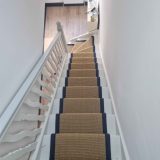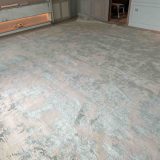A sisal stair runner but not made from sisal? How does that work?
If you’ve ever shopped for stair runners, you might have come across terms like “sisal look” or “faux sisal.” At first glance, it sounds contradictory — sisal is a natural fibre — so how can a runner be called a “sisal stair runner” if it’s not made of sisal? The answer lies in clever design, material science, and market demand.
Why Mimic Sisal?
Natural sisal has long been prized for its rugged, woven texture, neutral tones, and natural aesthetic. It pairs beautifully with many interior styles, especially those leaning toward organic or earth-driven décor. However, sisal has practical drawbacks:
-
It doesn’t deal well with moisture and spills — staining and water marks are common.
-
It can be rough underfoot, sometimes uncomfortable for bare feet or sensitive users.
-
Its durability in busy, high-traffic zones like staircases is questionable without constant maintenance.
Because of these trade-offs, many homeowners and designers prefer the look of sisal but the performance of synthetic materials. Enter the world of sisal-look alternatives — carpets made to mimic the texture and style of sisal, but with engineered properties (e.g. stain resistance, durability, easier cleaning).
Enter Anywhere Ca-rPET — A Faux Sisal Carpet
One of the standout products in this space is Anywhere Ca-rPET from Alternative Flooring. This is a woven carpet made from 100% recycled PET (polyethylene terephthalate) — so effectively, plastic bottles repurposed into carpet fibre.
-
It’s designed to mimic the aesthetic of sisal (the structure, texture, weave) while eliminating many of sisal’s practical downsides.
-
Because it’s synthetic, it’s more stain-tolerant, less sensitive to humidity, and easier to maintain.
-
Its tog rating (a measure of thermal resistance) is reported as 0.8 in some versions of the product — low enough to make it suitable for use with underfloor heating when paired with suitable underlays.
-
Alternative Flooring promotes it as suitable for busy homes — even in rooms where sisal would be impractical (kitchens, bathrooms)
Thus, a “sisal stair runner, but not sisal” is just a branding choice to communicate the look, while the material is actually an engineered, high-performance alternative.
Our Project: Fitting an Anywhere Ca-rPET Bouclé Re-vive Runner with Navy Blue Border
Project Spec & Purchase
We installed the Anywhere Ca-rPET Bouclé Re-vive stair runner, selecting a navy blue cotton border for a beautiful contrast. The version we used is available from Fenston Carter:
Alternative Flooring Anywhere Ca-rPET Bouclé Re-vive stair runner with border Fenstoncarter
This runner is described as a straight runner with borders on two sides, but Fenston Carter notes that they can also supply bends, turns, or custom cuts to accommodate winders or landings.
Fitting Around Windershttps://fenstoncarter.co.uk/products/alternative-flooring-anywhere-ca-rpet-boucle-re-vive-carpet-stair-runner-with-grey-border?srsltid=AfmBOoqgyjfKzs6r-49Ej29QvWlcXfGsyNNYQKVteaiQoQ5VqRB8VdcQ&utm_source=chatgpt.com
Because this home had winder stairs, we needed to carefully plan how the runner would wrap around the turns (often called kite-shaped or pie-shaped treads). We used a combination of:
-
Precise templating — measuring each winder tread, riser, and nosing to map the runner path.
-
Custom cuts at the borders/corners — trimming the runner border to neatly fold or mitre around curves.
-
Overlap and seam management — creating small overlaps or hidden seams to allow flexibility around angles without pulling or distortion.
-
Securing with grippers, staples, and edging — ensuring the runner stayed tight and clean even on the curved steps.
This kind of fitting demands experience with flat-woven carpets and an eye for detail, especially where border stripes or patterns must line up.
To see a demonstration of a similar runner being fitted, check out this video:
YouTube video: how to install a faux sisal runner to stairs
(Use it as a visual guide when planning your layout.)
Why This Choice Works
-
The bouclé structure gives subtle texture, echoing the look of sisal, but with softness and durability that make walking more comfortable.
-
Because the Ca-rPET fibre is engineered, it holds up better to wear, stains, and foot traffic than natural sisal.
-
Fibres are stable and low in moisture sensitivity, making it more reliable in stair zones where cleaning or dampness is a concern.
-
The cotton border adds a refined, tailored finish and frames the runner elegantly.
How to Template This Kind of Stair Runner
-
Video reference — Start by watching something like: How to make a template for a stair runner to understand general methods and layout principles. You can follow the principles shown there, adjusting for curved/winder sections.
-
Measure carefully — tread depths, riser heights, overlap allowances, nosing angles, width of runner vs stair.
-
Sketch each step — draw a template for each tread and riser, marking border reference lines to see how the runner will wrap or fold.
-
Plan border cuts — decide how border edges will join or mitre around corners; leave extra margin for trimming.
-
Mock layout — before cutting full runner, temporarily lay strips to confirm alignment and fit, especially across winders.
-
Cut & finish edges — use sharp blades and secure cut edges (serging, binding) as needed so they don’t fray.
-
Fixing & tensioning — use carpet grippers, underlay or foam if needed, and tension/stretching methods to keep the runner tight.

















